Pakistan nuclear weapons, 2023
By Hans M. Kristensen, Matt Korda, Eliana Johns | September 11, 2023
Pakistan nuclear weapons, 2023
By Hans M. Kristensen, Matt Korda, Eliana Johns | September 11, 2023
The Nuclear Notebook is researched and written by the staff of the Federation of American Scientists’ Nuclear Information Project: director Hans M. Kristensen, senior research fellow Matt Korda, and research associate Eliana Johns. The Nuclear Notebook column has been published in the Bulletin of the Atomic Scientists since 1987. This issue’s column examines Pakistan’s nuclear arsenal, which we estimate to currently include approximately 170 warheads and which could realistically grow to around 200 by 2025 at the current growth rate.
This article is freely available in PDF format in the Bulletin of the Atomic Scientists’ digital magazine (published by Taylor & Francis) at this link. To cite this article, please use the following citation, adapted to the appropriate citation style: Hans M. Kristensen, Matt Korda, and Eliana Johns, Pakistan nuclear weapons, 2023, Bulletin of the Atomic Scientists, 79:5, 329-345, DOI: https://doi.org/10.1080/00963402.2023.2245260
To see all previous Nuclear Notebook columns, go to https://thebulletin.org/nuclear-notebook.
Pakistan continues to gradually expand its nuclear arsenal with more warheads, more delivery systems, and a growing fissile material production industry. Analysis of commercial satellite images of construction at Pakistani army garrisons and air force bases shows what appear to be newer launchers and facilities that might be related to Pakistan’s nuclear forces.
We estimate that Pakistan now has a nuclear weapons stockpile of approximately 170 warheads (See Table 1). The US Defense Intelligence Agency projected in 1999 that Pakistan would have 60 to 80 warheads by 2020 (US Defense Intelligence Agency 1999, 38), but several new weapon systems have been fielded and developed since then, which leads us to a higher estimate. Our estimate comes with considerable uncertainty because neither Pakistan nor other countries publish much information about the Pakistani nuclear arsenal.

With several new delivery systems in development, four plutonium production reactors, and an expanding uranium enrichment infrastructure, Pakistan’s stockpile has the potential to increase further over the next several years. The size of this projected increase will depend on several factors, including how many nuclear-capable launchers Pakistan plans to deploy, how its nuclear strategy evolves, and how much the Indian nuclear arsenal grows. We estimate that the country’s stockpile could potentially grow to around 200 warheads by the late 2020s, at the current growth rate. But unless India significantly expands its arsenal or further builds up its conventional forces, it seems reasonable to expect that Pakistan’s nuclear arsenal will not continue to grow indefinitely but might begin to level off as its current weapons programs are completed.
Research methodology and confidence
The estimates and analyses made in the Nuclear Notebook are derived from a combination of open sources: (1) state-originating data (e.g. government statements, declassified documents, budgetary information, military parades, and treaty disclosure data); (2) non-state-originating data (e.g. media reports, think tank analysis, and industry publications); and (3) commercial satellite imagery. Because each one of these sources provides different and limited information that is subject to varying degrees of uncertainty, we cross-check each data point by using multiple sources and supplementing them with private conversations with officials whenever possible.
Analyzing Pakistan’s nuclear forces is particularly fraught with uncertainty, given the lack of official state-originating data. The Pakistani government has never publicly disclosed the size of its arsenal and does not typically comment on its nuclear doctrine. Unlike some other nuclear-armed states, Pakistan does not regularly publish any official documentation explaining the contours of its nuclear posture or doctrine. Whenever such details emerge in the public discourse, it usually originates from retired officials commenting in their personal capacities. The most regular official source on Pakistani nuclear weapons is the Inter Services Public Relations (ISPR), the media wing of the Pakistan Armed Forces, which publishes regular press releases for missile launches and occasionally couples them with launch videos.
Occasionally, other countries offer official statements or analysis about Pakistan’s nuclear forces. For example, the US Air Force’s ballistic and cruise missile threat reports include analyses of Pakistani missile forces. As Pakistan’s regional competitor, Indian officials also occasionally make statements about Pakistan’s nuclear weapons, although such statements must be taken with a grain of salt as they are often politically motivated. Similarly, Indian media sources often either exaggerate or minimize the characteristics of Pakistan’s arsenal, depending on the desired effect and audience. Pakistani media is also prone to frequent embellishment when describing the country’s arsenal. There are very few publications that researchers can turn to for reliable information about Pakistan’s nuclear forces and every rumor must be carefully investigated.
Given the absence of reliable data, commercial satellite imagery has become a particularly critical resource for analyzing Pakistan’s nuclear forces. Satellite imagery makes it possible to identify air, missile, and navy bases, as well as potential underground storage facilities. The greatest challenge of analyzing Pakistani nuclear forces with satellite imagery is the lack of reliable data with which to cross-check information revealed by images, particularly with regards to whether certain military bases are associated with nuclear or conventional strike missions, or both.
Overall, the lack of accurate data about Pakistan’s nuclear forces results in a lower degree of confidence in this Nuclear Notebook issue’s estimates relative to those of most other nuclear-armed countries.
Pakistan’s nuclear doctrine
Within its broader philosophy of “credible minimum deterrence,” which seeks to emphasize a defensive and limited nuclear posture, Pakistan operates under a nuclear doctrine that it calls “full spectrum deterrence.” This posture is aimed mainly at deterring India, which Pakistan identifies as its primary adversary. The belief that Pakistan’s nuclear weapons have been deterring India since the mid-1980s has solidified the value of nuclear weapons in the nation’s security calculus (Kidwai 2020, 2).
In May 2023, Lt. Gen. (Ret.) Khalid Kidwai—an advisor to Pakistan’s National Command Authority, which oversees nuclear weapons development, doctrine, and employment—gave a speech at the Institute of Strategic Studies Islamabad (ISSI) where he offered his description of what “full spectrum deterrence” entails. According to Kidwai (2023), “full spectrum deterrence” implies the following:
- “That Pakistan possesses the full spectrum of nuclear weapons in three categories: strategic, operational and tactical, with full range coverage of the large Indian land mass and its outlying territories; there is no place for India’s strategic weapons to hide.
- That Pakistan possesses an entire range of weapons yield coverage in terms of kilotons (KT), and the numbers strongly secured, to deter the adversary’s declared policy of massive retaliation; Pakistan’s “counter-massive retaliation” can therefore be as severe if not more.
- That Pakistan retains the liberty of choosing from a full spectrum of targets in a “target-rich India,” notwithstanding the indigenous Indian BMD or the Russian S-400, to include counter value, counter force and battlefield targets.”
According to Kidwai, who previously served as the director-general of the Strategic Plans Division (SPD), the “full spectrum” aspect of Pakistan’s deterrence posture encompasses both “horizontal” and “vertical” elements. The horizontal aspect refers to Pakistan’s nuclear “triad” encompassing the Army Strategic Force Command (ASFC), the Naval Strategic Force Command (NSFC), and the Air Force Strategic Command (AFSC). The vertical aspect refers to three tiers of destructive yield—“strategic, operational, and tactical”—as well as a range coverage “from zero meters to 2750 kilometers,” allowing Pakistan to target the entirety of India (Kidwai 2023).
Kidwai and other former Pakistani officials have explained that this posture—as well as Pakistan’s particular emphasis on non-strategic nuclear weapons—is specifically intended as a response to a perceived India’s “cold start” doctrine (Kidwai 2020). The “cold start” doctrine is an alleged intention by India to launch large-scale conventional strikes or incursions into Pakistani territory without triggering Pakistani nuclear retaliation. Pakistan has reacted to this perceived doctrine by adding several short-range, lower-yield nuclear-capable weapon systems specifically designed to counter military threats below the strategic level.
An example of such a low-yield, close-range nuclear capability is Pakistan’s Nasr (also known as Hatf-9) ballistic missile. In 2015, Kidwai stated that the Nasr was specifically “born out of a compulsion of this thing that I mentioned about some people on the other side toying with the idea of finding space for conventional war, despite Pakistan[’s] nuclear weapons” (Kidwai 2015). According to Kidwai, Pakistan’s understanding of India’s “cold start” strategy was that Delhi envisioned launching quick strikes into Pakistan within two to four days with eight to nine brigades simultaneously: an attack force which would involve roughly 32,000 to 36,000 troops. “I strongly believe that by introducing the variety of tactical nuclear weapons in Pakistan’s inventory, and in the strategic stability debate, we have blocked the avenues for serious military operations by the other side,” Kidwai (2015) explained.
After Kidwai’s (2015) statement, Pakistan’s Foreign Secretary Aizaz Chaudhry publicly acknowledged the existence of Pakistan’s “low-yield, tactical nuclear weapons,” apparently the first time a top government official had done so (India Today 2015). At the time, the tactical missiles had not yet been deployed but their purpose was further explained by Pakistani defense minister Khawaja M. Asif in an interview with Geo News in September 2016: “We are always pressurized [sic] time and again that our tactical (nuclear) weapons, in which we have a superiority, that we have more tactical weapons than we need. It is internationally recognized that we have a superiority and if there is a threat to our security or if anyone steps on our soil and if someone’s designs are a threat to our security, we will not hesitate to use those weapons for our defense” (Scroll 2016). In developing its nonstrategic nuclear strategy, one study has asserted that Pakistan to some extent has emulated NATO’s flexible response strategy without necessarily understanding how it would work (Tasleem and Dalton 2019).
Pakistan’s nuclear posture—particularly its development and deployment of tactical nuclear weapons—has created considerable concern in other countries, including the United States, which fears that it increases the risk of escalation and lowers the threshold for nuclear use in a military conflict with India. Over the past decade-and-a-half, the US assessment of nuclear weapons security in Pakistan appears to have changed considerably from confidence to concern, particularly because of the introduction of tactical nuclear weapons. In 2007, a US State Department official told Congress that, “we’re, I think, fairly confident that they have the proper structures and safeguards in place to maintain the integrity of their nuclear forces and not to allow any compromise” (Boucher 2007). After the emergence of tactical nuclear weapons, the Obama administration changed the tune: “Battlefield nuclear weapons, by their very nature, pose [a] security threat because you’re taking battlefield nuclear weapons to the field where, as you know, as a necessity, they cannot be made as secure,” as then US Undersecretary of State Rose Gottemoeller told Congress in 2016 (Economic Times 2016).
The Trump administration echoed this assessment in 2018: “We are particularly concerned by the development of tactical nuclear weapons that are designed for use in battlefield. We believe that these systems are more susceptible to terrorist theft and increase the likelihood of nuclear exchange in the region” (Economic Times 2017). The Trump administration’s South Asia strategy in 2017 urged Pakistan to stop sheltering terrorist organizations, notably to “prevent nuclear weapons and materials from coming into the hands of terrorists” (The White House 2017).
In the 2019 Worldwide Threat Assessment, US Director of National Intelligence Daniel R. Coats said, “Pakistan continues to develop new types of nuclear weapons, including short-range tactical weapons, sea-based cruise missiles, air-launched cruise missiles, and longer-range ballistic missiles,” noting that “the new types of nuclear weapons will introduce new risks for escalation dynamics and security in the region” (Coats 2019, 10). The Defense Intelligence Agency appeared to tone down its language slightly in its 2021 and 2022 Worldwide Threat Assessments, stating that “Pakistan very likely will continue to modernize and expand its nuclear capabilities by conducting training with its deployed weapons and developing new delivery systems…” but not explicitly noting the inherent escalation risks (Berrier 2021; 2022, 50).”
Pakistani officials, for their part, reject such concerns. In 2021, then-Prime Minister Imran Khan stated that he was “not sure whether we’re growing [the nuclear arsenal] or not because as far as I know … the only one purpose [of Pakistan’s nuclear weapons] – it’s not an offensive thing.” He added that “Pakistan’s nuclear arsenal is simply as a deterrent, to protect ourselves” (Laskar 2021).
Nuclear security, decision-making, and crisis management
After years of highly-publicized US concerns over the security of Pakistan’s nuclear weapons—including the Pentagon reportedly making contingency plans for their rendition in the event of a crisis—Pakistani officials have repeatedly challenged the notion that the security of their nuclear weapons is deficient (Goldberg and Ambinder 2011; MacAskill 2007). Samar Mubarik Mund, the former director of the country’s National Defense Complex, explained in 2013 that a Pakistani nuclear warhead is “assembled only at the eleventh hour if [it] needs to be launched. It is stored in three to four different parts at three to four different locations. If a nuclear weapon doesn’t need to be launched, then it is never available in assembled form” (World Bulletin 2013).
Despite Pakistan’s recent upgrades to the security of its military bases and facilities, at a Democratic Congressional Campaign Committee reception in October 2022, US President Joe Biden commented that Pakistan was “one of the most dangerous nations in the world” due to the lack of “cohesion” in its nuclear security and command and control procedures—a comment that Pakistan quickly and forcefully rebuked (Khan 2022).
Nuclear policy and operational decision-making in Pakistan are undertaken by the National Command Authority, which is chaired by the prime minister and includes both high-ranking military and civilian officials. The primary nuclear-related body within the National Command Authority is the Strategic Plans Division (SPD), which has been described by the former Director of the SPD’s Arms Control and Disarmament Affairs as “a unique organization that is incomparable to any other nuclear-armed state. From operational planning, weapon development, storage, budgets, arms control, diplomacy, and policies related to civilian applications for energy, agriculture, and medicine, etc., all are directed and controlled by SPD.” Additionally, SPD “is responsible for nuclear policy, strategy and doctrines. It formulates force development strategy for the tri-services strategic forces, operational planning at the joint services level, and controls movements and deployments of all nuclear forces. SPD implements NCA’s employment decisions for nuclear use through its NC3 systems” (Khan, F. H. 2019).
The National Command Authority was convened after India and Pakistan engaged in open hostilities in February 2019, when Indian fighters dropped bombs near the Pakistani town of Balakot in response to a suicide bombing conducted by a Pakistan-based militant group. In retaliation, Pakistani aircraft shot down and captured an Indian pilot before returning him a week later and convened the National Command Authority. Following the meeting, a senior Pakistani official gave what appeared to be a thinly veiled nuclear threat: “I hope you know what the [National Command Authority] means and what it constitutes. I said that we will surprise you. Wait for that surprise. … You have chosen a path of war without knowing the consequence for the peace and security of the region” (Abbasi 2019). In his memoir published in January 2023, former US Secretary of State Mike Pompeo mentioned the February 2019 crisis saying that India and Pakistan came “close” to a “nuclear conflagration” (Biswas 2023).
On March 9, 2022, India accidentally launched a BrahMos cruise missile, which crossed the border into Pakistan and traveled approximately 124 kilometers before crashing near the town of Mian Channu (Korda 2022). This was an extremely rare occurrence of a nuclear-armed country launching a missile into the territory of another nuclear power. A subsequent Indian inquiry found that the incident resulted from a deviation from standard operation procedures during a “routine maintenance and inspection” exercise. India made a public statement announcing these findings and terminated the three responsible Indian Air Force officers. However, Pakistan was not satisfied and rejected India’s “purported closure of the highly irresponsible incident,” insisting on a joint probe into the circumstances of the accident (Pakistan Ministry of Foreign Affairs 2022). A year after the incident, on March 10, 2023, Pakistan reiterated its standing request for a joint investigation, citing concern about the reliability of India’s command and control systems (Pakistan Ministry of Foreign Affairs 2023).
In addition to India’s opacity regarding the incident in the days immediately following the missile launch, it is notable that Pakistan may not have tracked the missile correctly during its flight. In a press conference following the missile launch, Pakistani military officials displayed a map showing their interpretation of the missile’s flight and noted that Pakistan’s “actions, response, everything … it was perfect. We detected it on time, and we took care of it” (ISPR 2022b). The flight path that Pakistan presented, however, included some discrepancies over where the missile had been launched, as well as its perceived target, and was publicly disputed by Indian sources (Korda 2022; Philip 2022).
According to one Indian news source, in the absence of clarification from India, Pakistan Air Force’s Air Defence Operations Centre immediately suspended all military and civilian aircraft for nearly six hours, and reportedly placed frontline bases and strike aircraft on high alert (Bhatt 2022; Philip 2022; Korda 2022; ISPR 2022c). Pakistan’s military sources stated that these bases remained on alert until 13:00 PKT on March 14th. (The Pakistan Standard Time (PKT) is typically 30 minutes behind of India Standard Time (IST).) Pakistani officials appeared to confirm this, noting that “whatever procedures were to start, whatever tactical actions had to be taken, they were taken” (ISPR 2022b).
While the US Air Force’s National Air and Space Intelligence Center Ballistic and Cruise Missile Report lists India’s BrahMos missile as conventional, this incident could potentially have escalated had it taken place during a previous period of notoriously tense relations between the two nuclear-armed countries (National Air and Space Intelligence Center 2017, 37). Moreover, Pakistan and India do not have robust transparency and crisis management mechanisms: Since 1988, the two countries have annually exchanged an annual list of nuclear facilities, and there is a high-level military hotline between the two countries; however, Pakistani officials noted that during the seven minutes of the missile’s flight India did not use the hotline to alert Pakistan of the accidental launch (ISPR 2022b). The two countries’ initial responses to the incident suggest that regional crisis management mechanisms may not be as reliable as intended.
Fissile materials production and inventory
Pakistan has a well-established and diverse fissile material production complex that is expanding. It includes the Kahuta uranium enrichment plant east of Islamabad, which appears to be growing with the near-completion of what could be another enrichment plant, as well as the enrichment plant at Gadwal to the north of Islamabad (Albright, Burkhard, and Pabian 2018). Four heavy-water plutonium production reactors appear to have been completed at what is normally referred to as the Khushab Complex some 33 kilometers south of Khushab in Punjab province. Three of the reactors at the complex have been added in the past 10 years. The addition of a publicly confirmed thermal power plant at Khushab provides new information for estimating the power of the four reactors (Albright et al. 2018).
The New Labs Reprocessing Plant at Nilore, east of Islamabad, which reprocesses spent fuel and extracts plutonium, has been expanded. Meanwhile, a second reprocessing plant located at Chashma in the northwestern part of Punjab province may have been completed and become operational by 2015 (Albright and Kelleher-Vergantini 2015). A significant expansion to the Chashma complex was under construction between 2018 and 2020, although it remains unclear whether the reprocessing plant continued to operate throughout that period (Hyatt and Burkhard 2020). In June 2023, China and Pakistan signed a memorandum of understanding (MOU) for a $4.8 billion deal to construct a new 1,200-megawatt reactor at Chashma (Shahzad 2023).
Nuclear-capable missiles and their mobile launchers are developed and produced at the National Defence Complex (sometimes called the National Development Complex) located in the Kala Chitta Dahr mountain range west of Islamabad. The complex is divided into two sections. The western section south of Attock appears to be involved in development, production, and test-launching of missiles and rocket engines. The eastern section north of Fateh Jang is involved in production and assembly of road-mobile transporter erector launchers (TELs), which are designed to transport and fire missiles. Satellite images regularly show the presence of TEL chassis for a variety of ballistic and cruise missiles: In June 2023, TEL chassis were visible for Nasr, Shaheen-IA ballistic missiles, and Babur cruise missiles (Figure 1). The Fateh Jang section has expanded significantly with several new launcher assembly buildings over the past 10 years, and the complex continues to expand. Other launcher and missile-related production and maintenance facilities may be located near Tarnawa and Taxila.
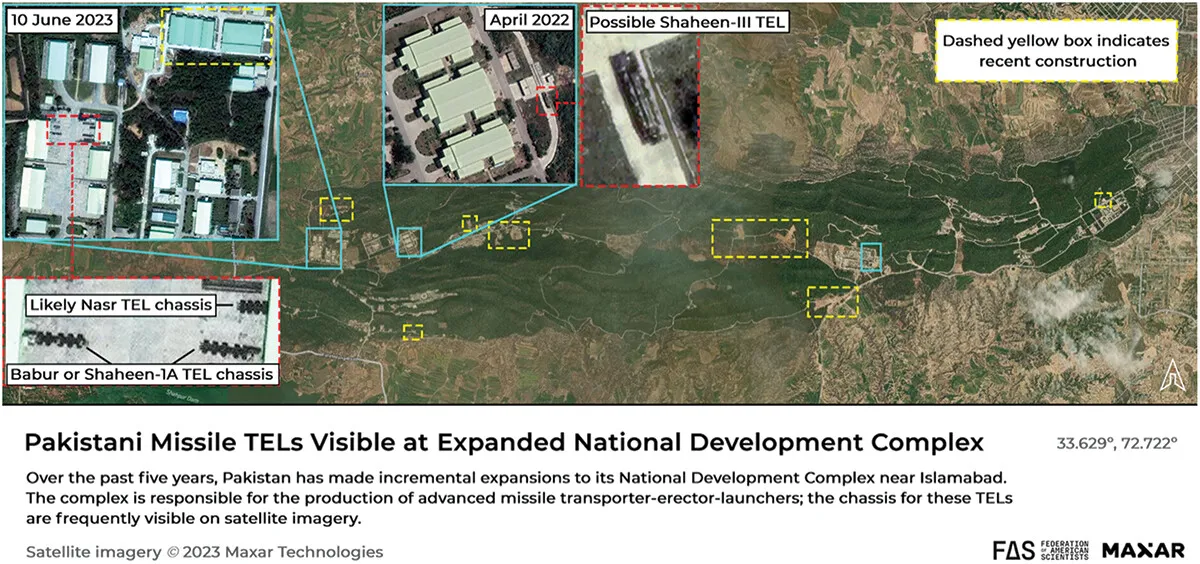
Little is publicly known about warhead production, but experts have suspected for many years that the Pakistan Ordnance Factories near Wah, northwest of Islamabad, serve a role. One of the Wah factories is located near a unique facility with six earth-covered bunkers (igloos) inside a multi-layered safety perimeter with armed guards.
A frequent oversimplification for estimating the number of Pakistani nuclear weapons is to derive the estimate directly from the amount of weapon-grade fissile material produced. As of the beginning of 2023, the International Panel on Fissile Materials estimated that Pakistan had an inventory of approximately 4,900 kilograms (plus or minus 1,500 kilograms) of weapon-grade (90 percent enriched) highly enriched uranium (HEU), and about 500 kilograms (plus or minus 170 kilograms) of weapon-grade plutonium (Kütt, Mian, and Podvig 2023). Assuming each first-generation implosion-type warhead’s solid core uses 15 to 18 kilograms (kg) of weapon-grade HEU or 5 to 6 kg of plutonium, this fissile material would theoretically be enough to produce a maximum of approximately 188 to 436 HEU-based single-stage warheads and 55 to 134 plutonium-based single-stage warheads if fully expended. However, Pakistan’s warhead designs may have undergone some iteration and have become more efficient.
It is important to note that calculating stockpile size based solely on fissile material inventory is an incomplete methodology that tends to overestimate the likely number of nuclear warheads. Instead, warhead estimates must take several other factors into account in addition to the amount of weapon-grade fissile material produced, including the warhead design choice and efficiency, warhead production rates, number of operational nuclear-capable launchers, number of launchers with dual-capability, and nuclear doctrine.
Nuclear warheads estimates must assume that not all of Pakistan’s fissile material is used for weapons. Like other nuclear-armed countries, Pakistan most probably keeps some fissile material in reserve. Pakistan also does not have enough nuclear-capable launchers to accommodate several hundreds of warheads. Moreover, all of Pakistan’s launchers are thought to be dual-capable, which means that some of them, especially the shorter-range systems, may serve non-nuclear missions. Finally, official statements often refer to “warheads” and “weapons” interchangeably, which leads to ambiguity as to whether they are referring to the number of launchers or the warheads being assigned to them.
The amount of fissile material in warheads—and the size of the warhead—can be reduced, and their yield increased, by using tritium to “boost” the fission process. Pakistan’s tritium production capability is poorly understood due to a lack of reliable public information. One study in early 2021 estimated that Pakistan could have produced 690 grams of tritium by the end of 2020, sufficient to boost over 100 weapons. The study assessed that warheads produced for delivery by the Babur and Ra’ad cruise missiles and the Nasr and Abdali missiles almost certainly would require a small, lightweight tritium-boosted fission weapon (Jones 2021). If Pakistan has produced tritium and uses it in second-generation single-stage boosted warhead designs, then the estimated HEU and weapons-grade plutonium would potentially allow it to build a maximum of 283 to 533 HEU-based warheads and 66 to 167 plutonium-based warheads, assuming that each weapon used either 12 kg of HEU or 4 to 5 kg of plutonium.[1] These calculations, however, produce results that are highly likely to be several hundred warheads more than Pakistan currently possesses, for the same reasons mentioned above.
We estimate that Pakistan currently is producing sufficient fissile material to build 14 to 27 new warheads per year, although we estimate that the actual warhead increase in the stockpile probably averages around 5 to 10 warheads per year.[2]
Nuclear-capable aircraft and air-delivered weapons
The aircraft most likely to have a nuclear delivery role are Pakistan’s Mirage III and Mirage V fighter squadrons. The Pakistani Air Force’s (PAF) Mirage fighter-bombers are located at two bases.[3] Masroor Air Base outside Karachi houses the 32nd Wing with three Mirage squadrons: 7th Squadron (“Bandits”), 8th Squadron (“Haiders”), and 22nd Squadron (“Ghazis”). A possible nuclear weapons storage site is located five kilometers northwest of the base (Kristensen 2009) and, since 2004, highly guarded underground facilities have been constructed at Masroor that could potentially be designed to support a nuclear strike mission. This includes a possible alert hangar with underground weapons-handling capability.
The other Mirage base is Rafiqui Air Base near Shorkot, which is home to the 34th Wing with two Mirage squadrons: the 15th Squadron (“Cobras”) and the 27th Squadron (“Zarras”). On February 25, 2021, Pakistan’s President, Dr. Arif Alvi, visited the base for the ceremony of 50th Anniversary of Mirages and Colours Award, which displayed at least 11 Mirages (President of Pakistan 2021).
The Mirage V is believed to have been given a strike role with Pakistan’ small arsenal of nuclear gravity bombs, while the Mirage III has been used for test launches of Pakistan’s Ra’ad air-launched cruise missiles (ALCM), as well as the follow-on Ra’ad-II. The Pakistani Air Force has added an aerial refueling capability to the Mirage, a capability that would greatly enhance the nuclear strike mission (AFP 2018). Several of the Mirages displayed at the award ceremony at Rafiqui Air Base in 2021 appeared to be equipped with refueling pods.
The air-launched, dual-capable Ra’ad ALCM is believed to have been test-launched at least six times, most recently in February 2016. The Pakistani government states that the Ra’ad “can deliver nuclear and conventional warheads with great accuracy” (ISPR 2011a) to a range of 350 kilometers (km) and “complement[s] Pakistan’s deterrence capability” by achieving “strategic standoff capability on land and at sea” (ISPR 2016a). During a military parade in 2017, Pakistan displayed what was said to be Ra’ad-II ALCM, apparently an enhanced version of the original Ra’ad with a new engine air-intake and tail wing configuration (Khan 2017). The Pakistani government most recently tested the Ra’ad-II in February 2020 and stated that the missile can reportedly reach targets at a distance of 600 km (ISPR 2020a). All test launches involving either Ra’ad system have been conducted from Mirage III aircraft.
There is no available evidence to suggest that either Ra’ad system had been deployed as of July 2023; however, one potential deployment site could eventually be Masroor Air Base outside Karachi, which is home to several Mirage squadrons and includes unique underground facilities that might be associated with nuclear weapons storage and handling.
To replace the PAF’s aging Mirage III and V aircraft, Pakistan has acquired more than 100 operational JF-17 aircraft—which are co-produced with China—and plans to acquire around another 188 JF-17s (Aamir 2022; Gady 2020; Quwa 2021; Warnes 2020). These aircraft are being continuously upgraded with new technology “blocks.” Pakistan reportedly inducted the first batch of 12 JF-17 Block III aircraft into the 16th (“Black Panthers”) squadron in March 2023 (Tiwari 2023). Several reports suggest that Pakistan may intend to incorporate the dual-capable Ra’ad ALCM onto the JF-17 so that the newer aircraft could eventually take over the nuclear strike role from the Mirage III/Vs (Ansari 2013; Fisher 2016; PakDefense 2020). In March 2023, during rehearsals for the 2023 Pakistan Day Parade (which was subsequently canceled), images surfaced of a JF-17 Thunder Block II carrying what resembled a Ra’ad-I ALCM, the first time such configuration was observed (Scramble 2023).
The nuclear capability of the PAF’s legacy F-16 aircraft is uncertain. Although Pakistan was obligated by its contract with the United States not to modify the aircraft to carry nuclear weapons, multiple credible reports subsequently emerged suggesting that Pakistan intended to do so (Associated Press 1989). In September 2022, the Biden administration agreed to a $450 million deal to help sustain Pakistan’s F-16 aircraft program (US Defense Security Cooperation Agency 2022).
The F-16A/Bs are based with the 38th Wing at Mushaf (formerly Sargodha) Air Base, located 160 kilometers northwest of Lahore in northeastern Pakistan. Organized into the 9th and 11th Squadrons (“Griffins” and “Arrows” respectively), these aircraft have a range of 1,600 km (extendable when equipped with drop tanks) and most likely are equipped to each carry a single nuclear bomb on the centerline pylon. If the F-16s have a nuclear strike mission, the nuclear gravity bombs attached to them most likely are not stored at the base itself but are potentially kept at the Sargodha Weapons Storage Complex, located 10 km to the south. In a crisis, the bombs could quickly be transferred to the base, or the F-16s could disperse to bases near underground storage facilities and receive the weapons there. Pakistan appears to be reinforcing the munitions bunkers, adding new tunnels, and installing extra security perimeters at the Sargodha complex.
The newer F-16C/Ds are based with the 39th Wing at Shahbaz Air Base outside Jacobabad in northern Pakistan. The wing upgraded to F-16C/Ds from Mirages in 2011 and, so far, has one squadron: the 5th Squadron (known as the “Falcons”). The base has undergone significant expansion, with numerous weapons bunkers added since 2004. As for the F-16A/Bs, if the base has a nuclear mission, the weapons attached to F-16C/Ds most probably are stored elsewhere in special storage facilities. Some F-16s are also visible at Minhas (Kamra) Air Base northwest of Islamabad, although these might be related to aircraft industry at the base. The F-16Cs were showcased in the 2022 Pakistan Day Parade.
Despite the reports about F-16s and the recent image of a Ra’ad ALCM loaded onto a JF-17, there are still too many uncertainties associated with these two aircraft to confidently attribute a dedicated nuclear strike role to either one. As a result, the PAF’s F-16s are omitted from Table 1 in this Nuclear Notebook, and the and JF-17s are listed with significant uncertainty.
Land-based ballistic missiles
Pakistan appears to have six currently operational nuclear-capable, solid-fuel, road-mobile ballistic missile systems: the short-range Abdali (Hatf-2), Ghaznavi (Hatf-3), Shaheen-I/A (Hatf-4), and Nasr (Hatf-9), and the medium-range Ghauri (Hatf-5) and Shaheen-II (Hatf-6). Two other nuclear-capable ballistic missile systems are currently under development: the medium-range Shaheen-III and the MIRVed Ababeel. All of Pakistan’s nuclear-capable missiles—except for the Abdali, Ghauri, Shaheen-II, and Ababeel—were showcased at the Pakistan Day Parade in March 2021 (ISPR 2021g). The Nasr, Ghauri, Shaheen-IA and II, as well as the Babur-1A and Ra’ad-II were featured during the 2022 Pakistan Day Parade (ISPR 2022c).
The Pakistani road-mobile ballistic missile force has undergone significant development and expansion over the past two decades. This includes possibly eight or nine missile garrisons, including four or five along the Indian border for short-range systems (Babur, Ghaznavi, Shaheen-I, Nasr) and three or four other garrisons further inland for medium-range systems (Shaheen-II and Ghauri).[3] In 2022 and 2023, Pakistan conducted significantly fewer public missile test launches than in earlier years, which may be related to Pakistan’s ongoing political instability and countrywide protests following the ousting and subsequent arrest of former Prime Minister Imran Khan in mid-2022.
The short-range, solid-fuel, single-stage Abdali (Hatf-2) has been in development for a long time. The Pentagon reported in 1997 that the Abdali appeared to have been discontinued, but flight-testing resumed in 2002, and it was last reported test-launched in 2013. The 200 kilometer-range missile has been displayed at parades several times on a four-axle road-mobile transporter erector launcher (TEL). The gap in flight-testing indicates the Abdali program may have encountered technical difficulties. After the 2013 test, Inter Services Public Relations stated that Abdali “carries nuclear as well as conventional warheads” and “provides an operational-level capability to Pakistan’s Strategic Forces.” It said the test launch “consolidates Pakistan’s deterrence capability both at the operational and strategic levels” (ISPR 2013); however, the Abdali—Pakistan’s oldest ballistic missile type—has not been tested since 2013 and was not displayed at the Pakistan Day Parades of 2021 and 2022. This could potentially indicate that the missile has been superseded by newer systems.
The short-range, solid-fuel, single-stage Ghaznavi (Hatf-3) was test-launched in 2019, 2020, and twice in 2021—its first reported test launches since 2014. In an important milestone for testing the readiness of Pakistan’s nuclear forces, the 2019 Ghaznavi launch was conducted at night. After each test, the Pakistani military stated that the Ghaznavi is “capable of delivering multiple types of warheads up to a range of 290 kilometers” (ISPR 2019c, 2020b, 2021b). Its short range means that the Ghaznavi cannot strike Delhi from Pakistani territory, and Army units equipped with the missile are probably based relatively near the Indian border (Kristensen 2016).
The Shaheen-I (Hatf-4) is a single-stage, solid-fuel, dual-capable, short-range ballistic missile with a maximum range of 650 km that has been in service since 2003. The Shaheen-I is carried on a four-axle, road-mobile TEL like the one used for the Ghaznavi. Since 2012, many Shaheen-I test launches have involved an extended-range version widely referred to as Shaheen-IA. The Pakistani government, which has declared the range of the Shaheen-IA to be 900 km, has used both designations. Pakistan most recently test launched the Shaheen-I in November 2019 and the Shaheen-IA in March and November 2021 (ISPR 2019d, 2021c, 2021d, 2021f). Potential Shaheen-1 deployment locations include Gujranwala, Okara, and Pano Aqil. The Shaheen-I was displayed at the 2021 Pakistan Day Parade, but it was replaced by the Shaheen-IA at the 2022 parade, indicating the latter system’s potential introduction into the armed forces (ISPR 2021g, 2022c).
One of the most controversial new nuclear-capable missiles in the Pakistani arsenal is the Nasr (Hatf-9), a short-range, solid-fuel missile originally with a range of only 60 km that has recently been extended to 70 km (ISPR 2017c). However, its range being too short to attack strategic targets inside India, Nasr appears intended solely for battlefield defensive use against invading Indian troops.[4] According to the Pakistani government, the Nasr “carries nuclear warheads of appropriate yield with high accuracy, shoot and scoot attributes” and was developed as a “quick response system” to “add deterrence value” to Pakistan’s strategic weapons development program “at shorter ranges to deter evolving threats,” including evidently India’s so-called Cold Start doctrine (ISPR 2011c, 2017a, 2017c). More recent tests of the Nasr system—including two tests in the same week in January 2019—sought to demonstrate the system’s salvo-launch capability, as well as the missiles’ in-flight maneuverability (ISPR 2019b, 2019d, 2019e).
The Nasr’s four-axle, road-mobile TEL appears to use a snap-on system that can carry two or more launch-tube boxes, and the system has been tested in the past using a road-mobile quadruple box launcher. The US intelligence community has listed the Nasr as a deployed system since 2013 (National Air and Space Intelligence Center 2013), and with a total of 15 tests reported so far, the weapon system appears to be well-developed. Potential deployment locations include Gujranwala, Okara, and Pano Aqil.
The medium-range, two-stage, solid-fuel Shaheen-II (Hatf-6) appears to be operational after many years of development. Pakistan’s National Defense Complex has assembled Shaheen-II launchers since at least 2004 or 2005 (Kristensen 2007), and a 2020 US intelligence community report states that there are “fewer than 50” Shaheen-II launchers deployed (National Air and Space Intelligence Center 2020). After the most recent Shaheen-II test launch in May 2019, the Pakistani government reported the range as only 1,500 km, but the US National Air and Space Intelligence Center (NASIC) continues to set the Shaheen-II’s range at 2,000 km (ISPR 2019a; National Air and Space Intelligence Center 2020). The Shaheen-II is carried on a six-axle, road-mobile TEL and can carry a single conventional or nuclear warhead.
Pakistan’s newer medium-range, two-stage, solid-fuel Shaheen-III was displayed publicly for the first time at the 2015 Pakistan Day Parade. Following a third test launch in January 2021, the Pakistani government said the missile could deliver either a single nuclear or conventional warhead to a range of 2,750 km, making it the longest-range system that Pakistan has tested (ISPR 2021a). Its latest test launch took place in April 2022 (Figure 2), which the Pakistani government said was “aimed at re-validating various design and technical parameters of the weapon system” (ISPR 2022a). The Shaheen-III is carried on an eight-axle TEL reportedly supplied by China (Panda 2016). The system may still require more test launches before it becomes operational.

The range of the Shaheen-III is sufficient to target all of mainland India from launch positions in most of Pakistan south of Islamabad. But the missile was apparently developed to do more than that. According to Gen. Kidwai, the range of 2,750 km was determined by a need to be able to target the Nicobar and Andaman Islands in the eastern part of the Indian Ocean that are “developed as strategic bases” where “India might think of putting its weapons” (Carnegie Endowment for International Peace 2015, 10). But for a 2,750-km range Shaheen-III to reach the Andaman and Nicobar Islands, it would need to be launched from positions in the very Eastern parts of Pakistan, close to the Indian border.
Pakistan’s oldest nuclear-capable medium-range ballistic missile, the road-mobile, single-stage, liquid-fuel Ghauri (Hatf-5), was most recently test-launched in October 2018 (ISPR 2018c). The Ghauri is based on North Korea’s Nodong medium-range ballistic missile. The Pakistani government states that the Ghauri can carry a single conventional or nuclear warhead to a range of 1,300 km. However, NASIC lists its range slightly lower at 1,250 km and suggests that “fewer than 50” Ghauri launchers have been deployed (National Air and Space Intelligence Center 2020). The extra time needed to fuel the missile before launch makes the Ghauri more vulnerable to attack than Pakistan’s newer solid-fuel missiles. Therefore, it is possible that the longer-range versions of the Shaheen may eventually replace the Ghauri. Potential deployment areas for the Ghauri include the Sargodha Central Ammunition Depot area and the Khuzdar Garrison, which expanded its perimeter in late 2017 to include three additional TEL garages.
On January 24, 2017, Pakistan test-launched a new medium-range ballistic missile called Ababeel that the government says is “capable of carrying multiple warheads, using multiple independent reentry vehicle (MIRV) technology” (ISPR 2017b).[5] The three-stage, solid-fuel, nuclear-capable missile, which is currently under development at the National Defense Complex, appears to be derived from the Shaheen-III airframe and solid-fuel motor and has a range of 2,200 km (ISPR 2017b; National Air and Space Intelligence Center 2020). After the test-launch, the Pakistani government declared that the test was intended to validate the missile’s “various design and technical parameters,” and that Ababeel is “aimed at ensuring survivability of Pakistan’s ballistic missiles in the growing regional Ballistic Missile Defence (BMD) environment, … further reinforc[ing] deterrence” (ISPR 2017b). Development of multiple-warhead capability appears to be intended as a countermeasure against India’s planned ballistic missile defense system (Tasleem 2017). Its status remains unclear as of July 2023.
Land-based missile garrisons
The total number and location of Pakistan’s nuclear-capable missile bases and facilities remains unknown. In particular, it is highly challenging to discern between Pakistani military bases intended to serve conventional-only strike roles and those intended to serve dual-capable or nuclear-specific strike roles.
Analysis of commercial satellite imagery suggests that Pakistan maintains at least five missile bases that could serve a role in Pakistan’s nuclear forces. Very little has changed with these bases since our most recent overview in 2016 (Kristensen 2016).
Akro Garrison (25.5483, 68.3343)
The Akro Garrison is located around 18 kilometers north of Hyderabad in the southern part of the Sindh Province, and around 145 kilometers away from the Indian border. The garrison covers an area of approximately 6.9 square kilometers, and it has undergone gradual expansion since 2004. The Akro Garrison consists of six missile TEL garages that appear to be designed for 12 launchers. Under the TEL garage complex, there is a unique underground facility, the construction of which can be seen through past satellite imagery. The underground facility has two cross-shaped sections connected by a central corridor that leads to two buildings on either side via covered access ramps.
Analysis of a vehicle training area in the northeast corner of the garrison shows what appear to be five-axle TELs for the Babur cruise missile weapon system.
Gujranwala Garrison (32.2410, 74.0730)
The Gujranwala Garrison is one of the largest military complexes in Pakistan (Figure 3). It covers nearly 30 square kilometers in the northeastern part of the Punjab Province and is located about 60 kilometers from the Indian border. Since 2010, the Gujranwala Garrison has added what appears to be a TEL launcher area immediately east of a likely storage site for conventional munitions, which became operational in 2014 or 2015. The TEL area consists of two identical sections, each of which contain several launcher garages as well as a possible weapons loading hall with reinforced embankments connected via covered passageway to what appears to be a reinforced weapons storage bunker. There is also a technical area slightly south of the main TEL area for servicing the launchers. The security perimeter seems to be designed for potentially adding a third TEL section.
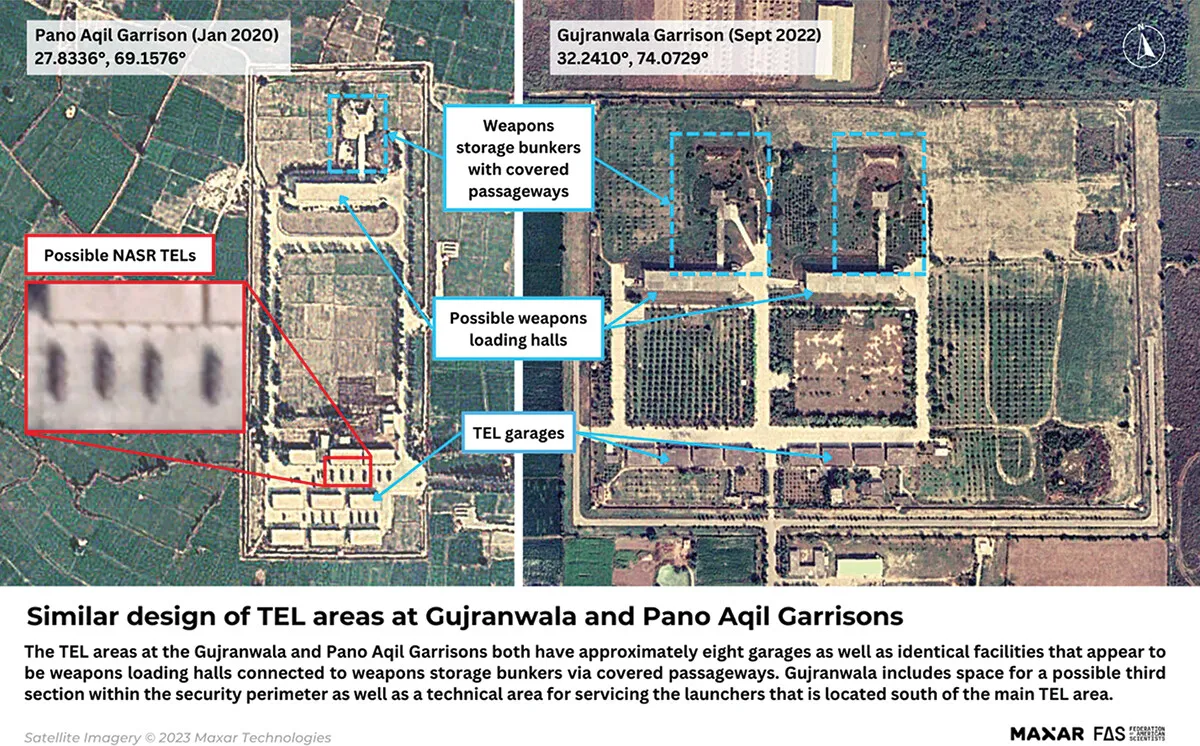
Several trucks that strongly resemble the Nasr short-range missile system can be seen on satellite imagery. Although it is impossible to be certain, these trucks appear to have a twin box launcher similar to that of which can be seen on Nasr test launch photos. The Nasr’s estimated range is the equivalent of the garrison’s distance from the Indian border.
Khuzdar Garrison (27.7222, 66.6241)
The Khuzdar Garrison is located approximately 220 kilometers west of Sukkur in south-east Balochistan Province, and the furthest known missile garrison from the Indian border. The base is split into two sections: a northern section and a southern section (where the TELs are based). The southern section of the base expanded its perimeter in late-2017 to include three additional TEL garages, bringing the total to six. Also included in this section are two multi-story weapon handling buildings with covered ramps leading to a possible underground nuclear storage area similar to the one visible at the Akro Garrison. Likely nuclear-capable missile launchers, possibly Ghauri or Shaheen-II TELs, have been spotted with commercial satellite imagery at Khuzdar. An eastern section of the base that appeared to be another TEL garage area was under construction over a decade ago; however, that expansion seems to have been canceled.
Pano Aqil Garrison (27.8328, 69.1575)
The Pano Aqil Garrison is located only 85 kilometers from the Indian border, in the northern part of Sindh Province, and is split up in several sections that cover a combined area of nearly 20 square kilometers. The double-fenced TEL area is located 1.8 kilometers northeast of the main garrison and includes eight garages (the last three were completed in 2017), each of which has spaces for six TELs. An additional ninth garage near the others appears to have openings for five vehicles. Altogether, this garrison could potentially support approximately 50 TELs; however, some of these garage spaces are likely to hold support vehicles as well. Large numbers of TELs, including for Babur and Shaheen-I missiles, are regularly visible at this garrison through commercial satellite imagery (Figure 3).
Slightly north of the TEL garages within the same double-fenced perimeter is a below-grade facility that appears to be a weapons storage igloo. The igloo is connected via a covered ramp to a multi-story TEL loading hall. The TEL and likely weapons storage areas are nearly identical in design to those visible at Gujranwala.
Sargodha Garrison (31.9722, 72.6838)
The Sargodha Garrison is a large complex located within and around the Kirana Hills, a subcritical nuclear test site used by Pakistan to develop its nuclear program from 1983 to 1990. Directly northwest of a likely conventional munitions storage area, there appear to be 10 dispersed potential TEL garages plus an additional two garages with different dimensions that could be used for maintenance. The TEL area does not have the same layout or perimeter as other TEL areas across the country, although this could be a function of the garrison’s age.
Directly east of the conventional munitions storage area is an underground storage area built into the side of the mountain range. At least 10 underground facility entrances are visible through commercial satellite imagery, as well as potential facilities for weapon and missile handling.
Ground- and sea-launched cruise missiles
Pakistan’s family of ground- and sea-launched cruise missiles is undergoing significant development with work on several types and modifications. The Babur (Hatf-7) is a subsonic, dual-capable cruise missile with a similar appearance to the US Tomahawk sea-launched cruise missile, the Chinese DH-10 ground-launched cruise missile, and the Russian air-launched AS-15. The Pakistani government describes the Babur as having “stealth capabilities” and “pinpoint accuracy” and “a low-altitude, terrain-hugging missile with high maneuverability” (ISPR 2011b, 2016b, 2018a, 2018b). The Babur is much slimmer than Pakistan’s ballistic missiles, suggesting some success with warhead miniaturization based on a boosted fission design.
The original Babur-1 ground-launched cruise missiles (GLCM) has been test-launched nearly a dozen times and is likely to be operational with the armed forces. Its road-mobile launcher appears to be a unique five-axle TEL with a three-tube box launcher that is different than the quadruple box launcher used for static display. At different times, the Pakistani government has reported the range to be 600 km and 700 km (ISPR 2011b, 2012a, 2012b, 2012c), but the US intelligence community sets the range much lower, at 350 km (National Air and Space Intelligence Center 2020).
Pakistan appears to be upgrading the original Babur-1 missiles into Babur-1A missiles by upgrading their avionics and navigation systems to enable target engagement both on land and at sea. Following the system’s most recent test in February 2021, the Pakistani military stated that the Babur-1A’s range was 450 km (ISPR 2021e).
Pakistan is also developing an enhanced version of the Babur known as the Babur-2 or Babur-1B GLCM.[6] The weapon has been test-launched in December 2016, April 2018, and December 2021 (ISPR 2016b, 2018a, 2018b, 2021d, 2021g). Indian news media reported that the Babur-2/Babur-1B had failed two other prior tests, in April 2018 and March 2020; however, this was not confirmed by Pakistan (Gupta 2020). With a physical appearance and capabilities like those of the Babur, the Babur-2/Babur-1B apparently has an extended range of 700 km, and “is capable of carrying various types of warheads” (ISPR 2016b, 2018a, 2018b). The fact that both the Babur-1 and the “enhanced” Babur-2/Babur-1B have been noted as possessing a range of 700 km indicates that the range of the initial Babur-1 system was likely shorter. NASIC has not released information on an enhanced system. After the first test in 2016, the Pakistani government noted that the system is “an important force multiplier for Pakistan’s strategic defense” (ISPR 2016b).
Babur TELs have been fitting out at the National Development Complex for several years and have recently been seen at the Akro garrison northeast of Karachi. The garrison includes a large enclosure with six garages that have room for 12 TELs and a unique underground facility that is probably used to store the missiles.
Pakistan is also developing a sea-launched version of the Babur known as Babur-3. The weapon is still in development and has been test-launched twice: On January 9, 2017, from “an underwater, mobile platform” in the Indian Ocean (ISPR 2017a); and on March 29, 2018 from “an underwater dynamic platform” (ISPR 2018a). The Babur-3 is said to be a sea-based variant of the Babur-2 GLCM, and to have a range of 450 km (ISPR 2017a).
The Pakistani government says the Babur-3 is “capable of delivering various types of payloads … [that] … will provide Pakistan with a Credible Second Strike Capability, augmenting deterrence,” and described it as “a step toward reinforcing [the] policy of credible minimum deterrence” (ISPR 2017a). The Babur-3 will most likely be deployed on the Pakistan Navy’s three Agosta-90B diesel—electric submarines (Khan 2015; Panda and Narang 2017). In April 2015, the Pakistani government approved the purchase of eight right air-independent propulsion-powered (AIP) submarines from China (Khan, B. 2019). The deal stipulated for four of the submarines to be constructed at the Wuchang Shipbuilding Industry Group (WSIG) in China, and for the remaining four to be built at Karachi Shipyard & Engineering Works in Pakistan (Sutton 2020). On December 21, 2022, Pakistan laid the keel for the first submarine, the Tasnim, and commenced the steel cutting of the second submarine at the Karachi Shipyard (Navy 2022). The first submarine under construction in China is expected to be delivered by the end of 2023 and the remaining four assembled in Karachi are expected to be completed by 2028 (Sutton 2020). It is possible that these new submarines, which will be called the Hangor-class, could eventually be assigned a nuclear role with the Babur-3 submarine-launched cruise missile.
Once it becomes operational, the Babur-3 will provide Pakistan with a triad of nuclear strike platforms from ground, air, and sea. The Pakistani government said the Babur-3 was motivated by a need to match India’s nuclear triad and the “nuclearization of [the] Indian Ocean Region” (ISPR 2018a). The Pakistani government also noted that Babur-3’s stealth technologies would be useful in the “emerging regional Ballistic Missile Defense (BMD) environment” (ISPR 2017a).
The future submarine-based nuclear capability is managed by Headquarters Naval Strategic Forces Command (NSFC), which the government said in 2012 would be the “custodian of the nation’s 2nd strike capability” to “strengthen Pakistan’s policy of Credible Minimum Deterrence and ensure regional stability” (ISPR 2012a). Kidwai in 2015 publicly acknowledged the need for a sea-based second-strike capability and said it “will come into play in the next few years” (Carnegie Endowment for International Peace 2015, 16). Kidwai may have been referring to the new Hangor-class submarines.
Pakistan is also developing a variant of the Babur cruise missile, known as the Harbah, that can be carried by surface vessels. In March 2022, Pakistan featured the new missile during the 11th Doha International Maritime Defence Exhibition and Conference (DIMDEX). The Pakistan Navy spokesperson described the Harbah as an “all-weather” subsonic cruise missile with anti-ship and land-attack capabilities and a range of approximately 290 km (Vavasseur 2022). According to the spokesperson, the Harbah has been inducted into the Pakistan Navy and deployed on Azmat-class surface ships (Vavasseur 2022). It remains unclear whether the Harbah will be dual-capable.
Research for this publication was carried out with generous contributions from the John D. and Catherine T. MacArthur Foundation, the New-Land Foundation, Ploughshares Fund, the Prospect Hill Foundation, Longview Philanthropy, the Stewart R. Mott Foundation, the Future of Life Institute, Open Philanthropy, and individual donors.
Notes
[1] These assumptions of estimated fissile material quantities for different weapon designs are adapted from Table A.1 of the International Panel on Fissile Materials (2015), Global Fissile Materials Report 2015: Nuclear Weapon and Fissile Material Stockpiles and Production report, http://fissilematerials.org/library/gfmr15.pdf.
[2] These estimates are based on reprocessing and uranium enrichment plant capacities in International Panel on Fissile Materials (2022), Global Fissile Materials Report 2022: Fifty Years of the Nuclear Non-Proliferation Treaty, https://fissilematerials.org/publications/2022/07/global_fissile_material_r.html, as well as more recent estimates by the International Panel on Fissile Materials.
[3] For detailed analysis of possible Pakistani air bases, nuclear facilities, and missile brigade locations, see Kristensen (2016).
[4] For an excellent analysis of this doctrine and Pakistan’s potential use of battlefield nuclear weapons, see Nayyar and Mian (2010).
[5] Note that the correct expansion of MIRV is multiple independently targetable reentry vehicle.
[6] It is possible that the Babur-2 and the Babur-1B are the same missile. Both names are referenced as “enhanced” versions of the Babur.
Together, we make the world safer.
The Bulletin elevates expert voices above the noise. But as an independent nonprofit organization, our operations depend on the support of readers like you. Help us continue to deliver quality journalism that holds leaders accountable. Your support of our work at any level is important. In return, we promise our coverage will be understandable, influential, vigilant, solution-oriented, and fair-minded. Together we can make a difference.
Keywords: Nuclear Notebook, Pakistan, ballistic missiles, cruise missiles, delivery systems, nuclear weapons
Topics: Nuclear Notebook, Nuclear Weapons






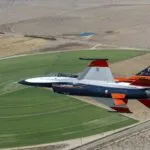



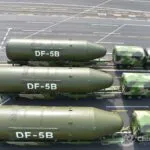
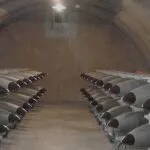

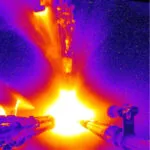





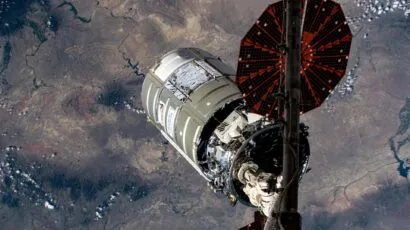




Pakistan has enough Nukes to send India back into the stone age for a very long time. Hopefully, better sense will prevail in both nations, although i dont expect much from the rabid nationalist party in charge of India… they have been encouraged by the US EU closeness due to Chinas percieved threat.
The comment of Syed reflects the illiterate, shabby and puerile mindset of the average Pakistani commentators. Their stone-age mental makeup, unfortunately, does not permit any meaningful dialogue. The international community, thankfully, has seen through the psyche of these yahoos.
Maybe Bhattacharjee has not been using social media lately. He would have known how much hate average hindus and andhbhakts have in their hearts against Islam and Muslims. The practices of Modi’s government in oppressing Kashmiris and muslim women in their country are evident of their extremely intolerant and narrow mindset.